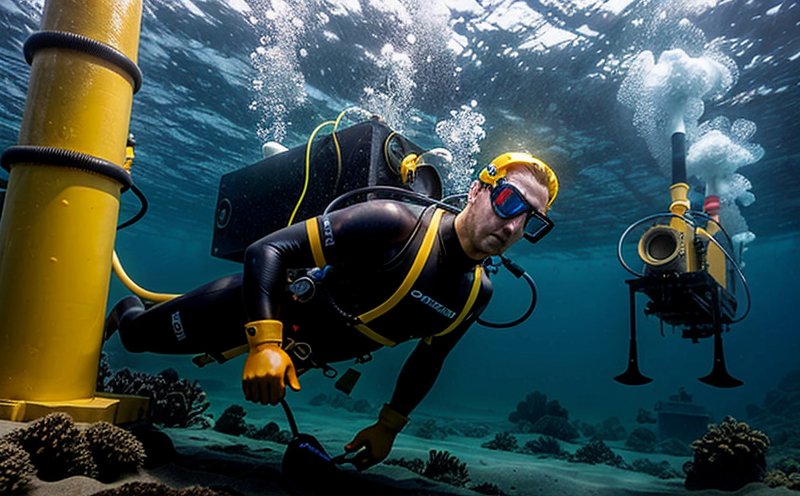ISO 13628-1 Design & Testing of Subsea Equipment for Petroleum & Gas
The ISO 13628 series of standards is a critical framework for ensuring the integrity and reliability of subsea equipment used in petroleum and gas industries. Specifically, ISO 13628-1 provides essential guidelines for the design and testing of subsea equipment, which are subject to extreme environmental pressures and operational conditions. This service ensures that all subsea equipment meets stringent requirements set forth by international standards.
The standard covers a wide range of materials, structures, and systems used in subsea environments, including pipelines, manifolds, risers, and other critical components. The testing procedures outlined in ISO 13628-1 are designed to validate the design against expected operational requirements under actual subsea conditions.
The scope of this service is broad but precise, encompassing all aspects from initial concept through final approval. It includes detailed guidelines for material selection, structural analysis, simulation testing, and field verification. Compliance with these standards ensures that equipment not only meets regulatory requirements but also performs reliably in the harshest marine environments.
Our laboratory adheres to rigorous quality control measures throughout every stage of this process, utilizing state-of-the-art facilities equipped specifically for subsea testing. This includes advanced hydrostatic pressure chambers capable of simulating deep-sea pressures and temperatures, as well as sophisticated acoustic testing equipment essential for assessing structural integrity under dynamic loading conditions.
Understanding the unique challenges faced by operators in offshore oil and gas fields is paramount to delivering accurate results that translate directly into safer operations. By adhering strictly to ISO 13628-1 guidelines, we provide comprehensive support across multiple stages of product development—from initial design reviews through final certification.
In summary, the service provided under ISO 13628-1 is crucial for ensuring that subsea equipment meets both regulatory and operational needs. It offers unparalleled assurance regarding safety and reliability in one of today’s most challenging industrial sectors.
Benefits
Adhering to ISO 13628-1 offers numerous advantages that extend beyond mere compliance. For quality managers, this service ensures that all subsea equipment is designed and tested according to the highest global standards, thereby reducing potential risks associated with non-compliant products.
Compliance officers will find value in knowing they are working within internationally recognized guidelines which help maintain consistent standards across different jurisdictions. R&D engineers benefit from having access to detailed specifications that guide their design decisions early on, potentially leading to innovative solutions tailored specifically for subsea applications.
For procurement teams, ensuring suppliers meet these stringent criteria can lead to more reliable partnerships and improved supply chain efficiency. Overall, this service enhances trust between stakeholders involved in offshore oil & gas projects while promoting best practices that contribute positively towards overall safety and sustainability goals.
Environmental and Sustainability Contributions
The implementation of ISO 13628-1 plays a significant role in enhancing environmental responsibility within the marine industry. By rigorously testing subsea equipment according to these standards, manufacturers can ensure their products contribute positively towards minimizing ecological impacts.
Emissions from offshore drilling activities are reduced when properly designed and tested subsea systems function efficiently without leaks or failures. Additionally, sustainable sourcing practices encouraged by adherence to ISO 13628-1 promote responsible use of resources throughout the supply chain, further supporting long-term environmental stewardship.
Moreover, this service helps reduce operational downtime by ensuring equipment reliability through robust testing protocols. Less frequent maintenance and repairs translate into lower carbon footprints over time, aligning with broader efforts to combat climate change.
Use Cases and Application Examples
- Pipeline Integrity Testing: Ensuring pipelines are capable of withstanding high-pressure environments without leakage or failure is crucial for safe transportation of oil & gas resources.
- Riser System Evaluation: Proper design and testing of riser systems help prevent accidents during drilling operations by ensuring they can withstand severe weather conditions at sea.
- Manifold Testing: Comprehensive evaluation of manifolds ensures their ability to connect various components safely while maintaining pressure integrity throughout complex subsea networks.
- Battery Pack Assessment: For renewable energy applications, testing battery packs used in underwater platforms helps guarantee consistent power supply during extended deployments.





